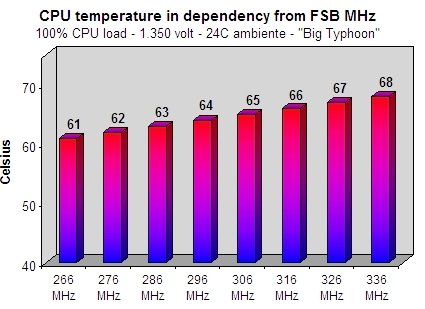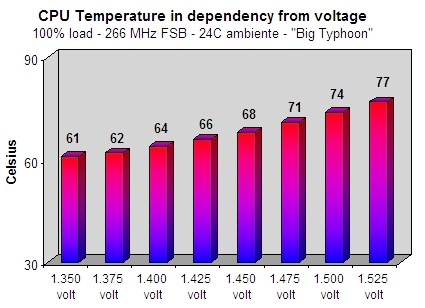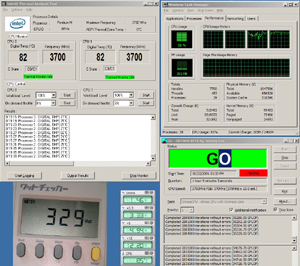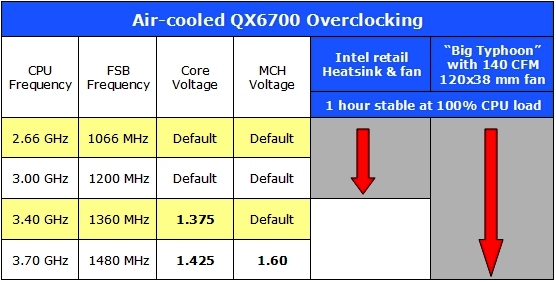|
|
Advertisement:
|
|
Intel QX6700 Quad-Core CPU |
|
Join the community - in the OCAU Forums!
|
Overclocking
OVERCLOCKING:
Although Intel has equipped the QX6700 heatsink with a stronger fan, we found that the device is soon overwhelmed by increasing heat when the CPU frequency is scaled up to above 3.00 GHz. With the retail heatsink, under full load, the QX6700 was already far above 70C at 3.00 GHz – even without increasing the voltage. We changed therefore to Thermaltake’s “Big Typhoon” heatsink with a 120x38mm fan pushing around 140 CFM. This combo allows running the QX6700 up to 10C cooler than the retail solution. The good news is that the QX6700 seems to offer some good overclocking headroom without increasing processor voltage. With the “Big Typhoon” we could push the frequency to around 3350 MHz without increasing the default voltage of 1.35 volt. This is a respectable result considering the far more severe thermal conditions from 4 cores running compared with 2 cores. Even at the default voltage the QX6700 was already reaching 68C under full load at 3.36 GHz.

It goes without saying that increasing the CPU voltage is increasing the CPU temperature as well. But it seems that 4 cores are magnifying this effect: we observed a steep rise in CPU temperature when increasing the voltage – even when the CPU frequency was left unchanged.

Above 3.40 GHz the QX6700 became unstable and we started the usual trial and error process of slightly increasing voltage and FSB frequency. The QX6700 comes with an unlocked multiplier that is downward and upward adjustable. Most 965 and 975X boards now offer the possibility to lower the multiplier via the BIOS even for regular “Core 2 Duo” CPUs. Intel had to open this loop-hole, otherwise “enhanced speed step” which drops the multiplier to reduce power consumption during idle time, would not work. The QX6700, at least the sample we tested, allows however to raise the multiplier as well. This could be a big advantage for hardcore overclocking with water or phase-change because it seems the QX6700 does not like the extremely high FSB frequencies, of up to 500 MHz, that many “Core 2 Duo” CPUs can handle. We hit a wall at around FSB 380 MHz. Raising the multiplier to 11 x gave us another 100 MHz core speed. We finally managed to boot into Windows XP at almost 3900 MHz. 100% stability was given at 3700 MHz. At this frequency and a relatively moderate 1.45 volt we could run the “Orthos” stability testing utility or 4 “folding at home” clients for several hours. One full GHz on top of the default frequency with air-cooling was far better than what we originally had expected considering the more severe thermal conditions of a quad-core processor. We estimate that with high-end water cooling or phase-change cooling, a QX6700 would run stable at 4.00 GHz.

3700 MHz under 100% load with Big Typhoon

|
|
Advertisement:
All original content copyright James Rolfe.
All rights reserved. No reproduction allowed without written permission.
Interested in advertising on OCAU? Contact us for info.
|

|


